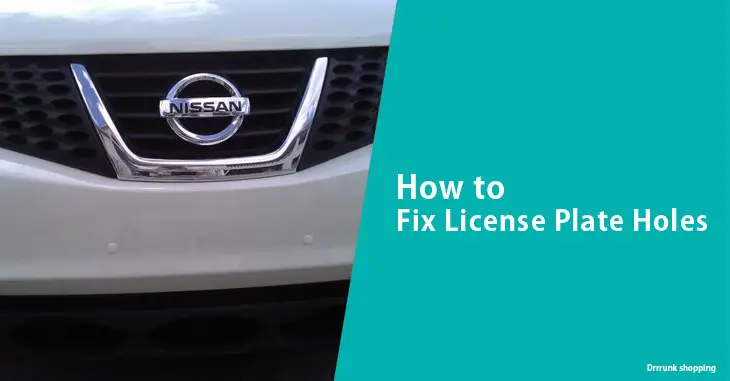Nowadays, most cars come with front and rear license plate holes already installed on the bumper.
However, if the previous owner bore additional holes (that do not match your preferences), you need to know how to fix license plate holes.
Bumper plugs are tiny accessories that cover plate holes and conceal the visible opening.
Note that bumper holes precisely fit rectangular-shaped plates or square-shaped plates. This, however, depends on your State’s traffic codes/laws.
Some country codes require rectangular front plates, while others recommend square front plates.
Read More: Top 10 Best Audi License Plates.
So, you require a guide to fix the front plate and rear plate holes correctly. Do not replace the entire bumper or take your car to a body shop because of the license plate holes.
Below is a step-by-step guide to fixing front plate holes, rear plate holes, and attaching rear license plate.
Steps to Fix License Plate Holes:
Accessories That You Require:
- 1/4 –inch hand drill
- Utility knife or an auto-retractable pen knife
- Electric hand drill
- Plastic bumper plugs
- Touch-up paint (if needed)
- Primer
- 1/8 or 5/16-inch drill bits for plastic/PVC
Step 1: Confirm the Number of Holes
Most cars come with two plate holes. Other custom-made plates can, however, come with anywhere between 4-5 plate holes.
So, counter-check the number of holes before proceeding to the next step.
Step 2: Purchase Matching Pairs of Bumper Plugs
Usually, bumper plugs are available in pairs. If you want to fix two plate holes, you can get a pair at affordable rates.
If you intend to fix more than two holes, you need to purchase three pairs.
Note: Check that you purchase correctly matching plugs.
If you do not find a paint-matching pair, you will have to paint the plugs accordingly.
Painting unmatched plate plugs:
- Prepare the touch-up paint and primer
- Apply two coats of primer on the plugs to get an even tone. Give it a few minutes to dry before you move to the next step.
- After the plugs are dry, apply the touch-up paint evenly on the entire plug. (You can apply anywhere between 2 to 3 coats depending on your car’s color shade.)
- Let the plugs dry for approximately 24 hours before fixing.
- Apply two coats of clear coat spray paint on the plugs. A coat of clearcoat gives the plugs a more polished or glossy appearance. (Wipe off the excess paint coat with a dry cloth)
Step 3: Drill the License Plate Holes to Fit the Plugs
License plate holes are usually thin. So, use the ¼-inch drill to expand the holes to the required size. Use precise plastic drill bits to get a much cleaner result.
If the license plate plugs have a large stem, use the wide drill bit of the same size.
Use a utility knife to scrape off the overlapping plastic cavity from the tip of the drilled hole. But be extra careful not to damage the bumper paint.
Step 4: Countercheck if the Plug Fits the Plate Holes
Before plugging the plate holes or even adjusting license plate bumper holes, check if the plugs fit the holes to avoid making wider holes.
Step 5: Plug the Plate Holes
Finally, plug the holes and ensure they fit precisely. The plate plugs should pop in smoothly.
Repeat the above five steps to fix the rear plate holes. Furthermore, this procedure can be used for the license plate screw hole stripped fixing.
Also, check this guide: How to Remove Audi License Plate Bracket.
How to Hang a License Plate without Drilling Holes
There are many ways for hanging license plates without drilling holes. However, we will look at the most efficient hack of them all.
- Gather all the necessary tools. These include four pieces of circular magnets, a plastic license plate bracket, and epoxy.
- Mix enough amount of epoxy on a separate container
- Apply the epoxy on one phase of each magnet
- Stick the magnets (3 0r 4) strategically on the backside of the bumper and let it dry. You can get a cleaner result if you can detach the bumper from the car.
- Stick other magnets (maybe 5 or 6) on the license plate brackets and let it dry for a few hours
Ensure that the magnets on the bumper are in the same position as the magnets on the license plate.
- Spray the magnets with two coats of spray paint to ensure a much cleaner finish
- Place the license plate bracket on the bumper and check if it sticks correctly.
- Use a few nuts to screw the license plate securely on the license plate bracket.
- Finally, hang the license plate.
Expert Advice:
- You can use the chrome-plated hole plugs as alternatives to plastic plugs
- Purchase the plugs corresponding to your car’s make, model, and color.
- Using touch-up paint has its advantages compared to ordinary paint. Touch-up paint comes in different color codes. So, you can pick the correct code that matches your car.
Conclusion
The good thing with bumper plugs is that they do not require any additional painting or alterations. These accessories can be plugged in smoothly into place without any challenge whatsoever.
So, always consider bumper plugs to fill the previously installed license plate holes on the plastic bumper.
Fixing the license plate requires few skills and precision. However, this particular guide should help you to fix a license plate hole.


